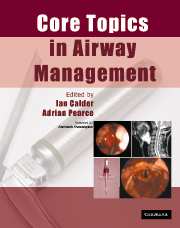Book contents
- Frontmatter
- Contents
- List of contributors
- Preface
- Acknowledgements
- List of abbreviations
- 1 Anatomy
- 2 Physiology of apnoea and hypoxia
- 3 Physics and physiology
- 4 Cleaning and disinfection of airway equipment
- 5 General principles
- 6 Maintenance of the airway during anaesthesia: supra-glottic devices
- 7 Tracheal tubes
- 8 Tracheal intubation of the adult patient
- 9 Confirmation of tracheal intubation
- 10 Extubation
- 11 Light-guided intubation: the trachlight
- 12 Fibreoptic intubation
- 13 Retrograde intubation
- 14 Endobronchial and double-lumen tubes, bronchial blockers
- 15 ‘Difficult airways’: causation and prediction
- 16 The paediatric airway
- 17 Obstructive sleep apnoea and anaesthesia
- 18 The airway in cervical trauma
- 19 The airway in cervical spine disease and surgery
- 20 The aspiration problem
- 21 The lost airway
- 22 Trauma to the airway
- 23 Airway mortality associated with anaesthesia and medico-legal aspects
- 24 ENT and maxillofacial surgery
- 25 Airway management in the ICU
- 26 The airway in obstetrics
- Index
22 - Trauma to the airway
Published online by Cambridge University Press: 15 December 2009
- Frontmatter
- Contents
- List of contributors
- Preface
- Acknowledgements
- List of abbreviations
- 1 Anatomy
- 2 Physiology of apnoea and hypoxia
- 3 Physics and physiology
- 4 Cleaning and disinfection of airway equipment
- 5 General principles
- 6 Maintenance of the airway during anaesthesia: supra-glottic devices
- 7 Tracheal tubes
- 8 Tracheal intubation of the adult patient
- 9 Confirmation of tracheal intubation
- 10 Extubation
- 11 Light-guided intubation: the trachlight
- 12 Fibreoptic intubation
- 13 Retrograde intubation
- 14 Endobronchial and double-lumen tubes, bronchial blockers
- 15 ‘Difficult airways’: causation and prediction
- 16 The paediatric airway
- 17 Obstructive sleep apnoea and anaesthesia
- 18 The airway in cervical trauma
- 19 The airway in cervical spine disease and surgery
- 20 The aspiration problem
- 21 The lost airway
- 22 Trauma to the airway
- 23 Airway mortality associated with anaesthesia and medico-legal aspects
- 24 ENT and maxillofacial surgery
- 25 Airway management in the ICU
- 26 The airway in obstetrics
- Index
Summary
Anaesthetic trauma
Dental damage
Dental damage most often occurs during direct laryngoscopy, the upper incisors are most frequently damaged and diseased or restored teeth are most at risk. Avulsed teeth should be stored in milk or saline (never water) for possible re-implantation by dental surgeons. Dental damage is the most common cause of a civil action against anaesthetists, and a careful assessment of pre-anaesthetic dental condition may prevent subsequent claims.
Naso/pharyngeal/oesophageal damage
Damage to the nasal turbinates, even complete avulsion, or perforation of the nasopharyngeal mucosa can occur during nasal intubation. Intubation over a guide, such as a suction catheter or endoscope is recommended. Se psis following pharyngeal or oesophageal perforation during intubation is one of the principal causes of anaesthetic mortality. Urgent treatment is required (antibiotics and drainage) and patients in whom perforation is suspected should be closely observed for symptoms (sore throat, cervical or chest pain, dysphagia) and signs (fever).
Glottic damage
A persistent sore throat, weak cough and dysphonia should prompt a laryngoscopy. Possible causes include subluxation of an arytenoid cartilage (Figure 22.2), vocal cord palsy or haematoma (Figure 22.3). The diagnosis of arytenoid subluxation has followed intubations that were regarded as easy by the anaesthetist, but Paulsen et al failed to induce arytenoid subluxation in cadaver specimens despite strenuous efforts. They proposed that trauma at intubation causes ‘cricoarytenoid joint dysfunction’.
Tracheal damage
Acute
Perforation or rupture can occur during intubation and is not always obvious immediately. The cardinal sign is subcutaneous air. A tracheal tube may need to be placed below a rupture. The use of fibreoptic placement of two microlaryngoscopy tubes has been reported.
- Type
- Chapter
- Information
- Core Topics in Airway Management , pp. 169 - 172Publisher: Cambridge University PressPrint publication year: 2005



